How To Learn 3000+ Kanji (Including the Jōyō Kanji) in 90 Days
Before we get into this, be warned that this guide is long. I’ve poured my sweat and tears into this blog post and I feel that this is the ultimate guide to remembering kanji. Providing you stick to this article, you will be able to learn the meanings of 2000 to 3000 kanji in just a few months (however you should do this at a pace that suits you, 3000 in 90 days is possible but it will take a fair bit of time and hard work so do be aware of that). I would highly recommend either bookmarking this page, or dragging the URL of this post to your desktop, so that you can easily come back to it later.
Kanji are a lot easier to learn than you might think. Yes, I said it. Kanji are easy to learn. You can call me stupid, crazy, all the swear words under the sun, but they are easy.
The only reason people find them hard is because they are going about learning them in an inefficient manner. Kanji seem to be impossible for western learners of Japanese to get their heads round but with the right mindset, method and tools it can be one of the easiest parts of learning the Japanese language.
There are a few other guides out there that are similar to this one, however there are some issues that I’ve seen that none of them address and they also teach you how to do this in manner that means you won’t actually be able to write the characters.
I will discuss this in more detail so that you know what to do if you want to learn how to write, as well as to read, real Japanese.
This method still works even if you don’t care about writing by hand though, and is by far the fastest way to get you to a high level of Japanese reading comprehension.
During my early stages of learning Japanese, I went to some Japanese night classes at my University.
At the time I used to really envy the Chinese students as they already had the “alphabet” down before even getting started with the language.
They didn’t have to waste any time learning a new character set because Japanese kanji originate from Chinese.
For them, all they needed to do was learn the readings while the meanings of Japanese kanji and words came quickly to them as they could already infer what words meant.
They already knew how to write the characters (even if they are written slightly differently) as well as their meanings which is a massive head-start.
One of the biggest reasons westerners learning Japanese seem to struggle though is because they pay to much attention to all the rumors about kanji being impossible to learn.
Among those learners, some of them spend years and years studying kanji and never make any progress in their Japanese as they are using incredibly inefficient techniques or methods, while never moving away from their kanji studies to focus on actual, real Japanese.
But with the right method, kanji can be one of the easiest parts of learning Japanese.
Which is exactly why I have written this guide.
To help you learn Kanji without wasting years of your life in doing so.
I know tonnes of people (including myself) that have used the method that I am going to share with you today and many of them have gone on to become insanely good at Japanese.
For example this guy and this guy (check their Japanese with a native, they will be impressed).
For anyone interested in my ability, there’s a video below of me speaking (Japanese and English subs available).
If you find anyone who has got to a near-native level of fluency in Japanese, or who has gotten to a very high level of fluency, I can almost guarantee that they will have mastered kanji as well.
This is because kanji are essential for being able to read Japanese, and without extensive reading in Japanese, it’s pretty difficult to get very articulate in using the language.
And while I consider the act of listening far more important than reading, especially in the early stages of learning a new language, kanji is something you are going to want to get out of the way early on as it will make you much faster at learning Japanese in the long run.
That’s why I recommend that you:
Learn 3000 Kanji Before Anything Else
During the next 3 months it will take you to learn these kanji, I also recommend that you listen to as much Japanese as you can.
Immersion is the best way to get you understanding the language as quickly as possible, which is why I recommend that you do passive listening while you learn kanji, but that’s an entire different post altogether…
For now though, besides listening to Japanese, don’t do any other form of studying until you have finished kanji.
There are a few reasons for this.
Without Getting Kanji Out of The Way, Learning Japanese Will Become A Massive Burden
The problem with kanji is that it seems like such a massive task that if you don’t actually get it out of the way first then it will just weigh you down throughout the rest of your studies.
You will start seeing it as this mammoth of a wall that you could never even think about climbing over. This will put pressure on your studies and will make it more likely that you will quit Japanese as you will constantly be thinking about how it’s too difficult to learn kanji and thus Japanese.
As soon as you start spending time worrying about your studies, you spend more time not actually studying and then actually studying the language seems even harder than it did before. This is a very vicious circle and is one of the biggest reasons that Japanese learners quickly give up learning the language.
You are probably already feeling this to some extent and I expect that’s part of the reason why you’ve ended up on this post, but don’t worry this post should solve that.
Now, I’ve already said that kanji are actually easy to learn. But unless you read on, follow this guide and actually learn them, you will no doubt still consider them to be this impossible task that you could never ever complete and you will inevitably give up learning them.
So just keep on reading. You will see why kanji are actually incredibly easy to learn and hopefully you won’t get weighed down by their existence.
Without Knowing the Meanings of Kanji, Learning to Read Japanese Becomes Practically Impossible
Another reason why you should learn kanji first is because without knowing them, reading real Japanese becomes insanely hard to do.
Now we all have different goals when it comes to learning Japanese, but assuming that you want to get to a decent level of fluency then you are going to need to know kanji.
If you don’t study the meanings of kanji before trying to read Japanese text then you don’t give yourself a chance.
There will be too much going on for you to remember each character and you have nothing to help you memorize all that information despite rote memorization, which is super inefficient.
To give yourself a chance at even reading Japanese, it’s best to learn all the meanings of the characters first.
I’m going to talk about this more further down the post but it essentially gives you a stepping stone into reading real Japanese written by real natives.
Knowing Kanji Makes Studying Japanese Much More Efficient
Knowing the meanings of kanji allows studying Japanese a lot more efficient. For example, a lot of Japanese words are built up of two different kanji characters. Knowing the individual meanings of each character that build up a word can (in the majority of cases) allow you to instantly know a words meaning.
Basically, kanji act as little building blocks of meaning and they can be combined together to create other blocks of meaning.
This is pretty amazing as it means that you can often know the meaning of new words the instant you see them.
Yup, that’s right.
You will be able to infer their meaning without looking them up in English or checking a Japanese dictionary.
Once you start learning the readings (via sentence mining and reading Japanese), you will eventually start picking up on certain patterns, and while you shouldn’t rely on them too much as there are plenty of exceptions, you will eventually be able to guess a words kanji just by hearing how the word is said.
This will be due to how the word was said and the context it was used in. From here you can make a very good educated guess as to what kanji are used for the word you heard, which is pretty awesome and it feels great when this happens.
Knowing kanji also allows you to ask Japanese natives what new words mean.
This has happened to me so many times throughout learning Japanese. Me and my girlfriend would be talking away in Japanese and she would say a word that I didn’t know.
Instead of getting her to explain for ages about what the word means, I can just ask her what the kanji are for the word.
Doing this means that the Japanese person can just tell you, or even write down, the kanji for you. This is awesome as it means that you can jot it down quickly so that you can learn it later.
If it’s a word you hear in a conversation then you are going to need to know it.
Learning What a Kanji Means is More Important Than Learning How It’s Read
Kanji are used across a wide range of languages and in each language they are pronounced completely differently.
So in essence, kanji really just represent meaning, how each character is read is very much an after thought in all of these languages.
Each character has a specific meaning that can carry across different languages which means that people who know languages that use kanji have a massive benefit when it comes to learning other languages that use kanji.
In fact, here’s an example of the same text across different languages. You can see just how similar they are.

By YanTTO – 投稿者自身による作品, CC 表示-継承 4.0, Link
I’ve experienced this myself when going through the Chinese section of my University library. On many occasions I’ve found myself being able to tell what certain books were about due to my knowledge of Japanese kanji, yet I know zero Chinese. How cool is that?
For a Chinese student learning Japanese, it’s clear to see how much easier it can be for them to learn to read Japanese as they already know each character’s meaning.
If they started to read a piece of text without knowing how to read each character, and they already knew hiragana and katakana, then they are going to have a much higher comprehension rate than someone who doesn’t know kanji at all.
They will, at the very least, be able to understand the overall meaning of a Japanese text.
Therefore learning the meanings of kanji can be a massive benefit for you, and your Japanese studies, as it gives you a great stepping stone into becoming able to read the language.
Knowing the meanings of kanji is also incredibly useful as it means that when you see words that you don’t know how to read, you can still understand what’s being said as you know what each character means and can therefore infer the words meaning.
Even Japanese people do this.
For example, I was watching one of まんさや’s videos this morning and within the first 50 seconds she came across a word she couldn’t read, “虚偽” (きょぎ), meaning “falsehood, lie, misinformation etc.” and because she couldn’t read it she gave up trying and just said a more common word with a similar meaning, 偽り (いつわり), meaning “lie, falsehood, fiction etc.”.
This is because she knows what the word means, even if she can’t read it or doesn’t know it, because she already knows the meanings of the characters that build up the word.
Pretty useful right?
When it comes to learning the readings of each character however, you have to realize that Japanese kanji are a complete mess.
There is no systematic way of working out which characters are pronounced in what way because there are so many exceptions, specific readings, words that use the same kanji etc.
As you start reading Japanese, you will no doubt notice some patterns but these patterns aren’t 100% set in stone.
There are many different ways of reading each character.
Characters will have at least 2 readings, onyomi and kunyomi, but even then, there are often multiple onyomi and kunyomi readings for each character which are used in different usages and these readings can get warped in really strange ways as well.
A lot of kanji, especially the more commonly used ones, also tend to have a variety of unrelated meanings depending on the words that they are used to create.
Here’s an example of one of the most common, yet most difficult kanji to truly master due to its many readings and usages.
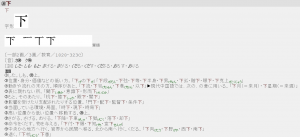
This is the character for “below” and it has 2 onyomi, 10 kunyomi and over 11 usages according to this dictionary.
It’s also used in hundreds of words in Japanese in order to make other words with different meanings and 下 in these words can be read in a many number of ways.
Here’s a list of words that use 下 in them, but this isn’t even a full list, there are many more.
下の下・下段・下弦・下等・下半身・下男・下劣・階下・眼下・下克上・下流・下旬・下巻・下月・下星期・閾下・意識下・監督下・条件下・時局下・下降・下車・下獄・下付・下賜・下知・下向・下校・下番・案下・以下・已下・雨下・会下・轅下・垣下・嚥下・咽下・屋下・階下・垓下・閣下・管下・眼下・緩下剤・旗下・机下・麾下・貴下・脚下・却下・猊下・形而下・月下氷人・県下・現下・言下・降下・閤下・高下・胯下・呉下・刻下・西下・座下・傘下・時下・耳下腺・膝下・卸下・樹下石上・城下・上下・臣下・垂下・臍下丹田・泉下・宣下・足下・尊下・台下・地下・治下・直下・沈下・低下・滴下・殿下・天下・投下・灯下・都下・南下・配下・幕下・白帯下・皮下・鼻下長・卑下・府下・部下・陛下・放下・凡下・無下・目下・門下・落下・李下・流下・隷下・零下・廊下・下火・下炬・足下・覆下園・御半下・嚊天下・上下・日下部鳴鶴・下文・下松・下手人・下種・下衆・下司・下品・下呂温泉・帯下・轂下・氷下魚・芝翫下駄・下沓・下道・下方・下沓・下総・下人・下女・下河辺長流・下様・下方・下諏訪・下館・下野・下毛野・下総・下妻・下仁田・下関・下総・下館・従下・牆下・砌下・臍下・手下・天下・始馭天下之天皇・下手・紅下翅・両下・水下経・下枝
Hopefully you can see what I mean by Japanese kanji being a mess.
Where does this lead us then?
Well, to put it simply, if you where to learn kanji one at a time, attempting to master every part of the character before moving on to the next, then you would get nowhere.
In fact, it would take years.
It’s just too much information for you to handle at once and a lot of it isn’t necessary for a beginner.
It’s been known for years now that the human brain prefers learning things in small chunks.
Attempting to learn the meaning, writing, all the readings as well as some vocabulary words for a kanji, all at the same time, is overload and you won’t remember a thing.
So instead of taking this painful approach, the smarter thing to do would be to learn all the meanings first and then learn the readings of whole words as you come across them in natural Japanese and in your studies.
This way, not only do you not have to waste precious time on useless or rare meanings, but over time you will eventually build up a knack for guessing what certain kanji mean, and even how they are read, much like how you are able to guess how a word that you’ve never seen before is pronounced or spelled in English, despite never seeing it or hearing it before.
Essentially, given enough time, you will develop an instinctive knowledge of the readings and meanings of each character.
The method we are going to use focuses on learning the meanings of kanji first so your ability to instinctively guess a word, or a kanji’s meaning, will develop first but eventually, given enough exposure to Japanese text, you will also develop the same ability to guess kanji readings.
Even now I can come across a new word that consists of kanji that I know that I might not know how to say, however I can usually infer the meaning correctly due to already having memorized the meanings of all the most common 3000 kanji.
Most of the time I can also correctly infer both the meanings AND the reading, but if not then I can, 99% of the time, infer the meaning.
The same thing happens for Japanese natives and I’ve seen it occur many times when talking to my girlfriend.
Occasionally I will find a new word that is pretty difficult and if I am talking with my girlfriend then sometimes I’ll ask her if she could explain to me what the word means.
Every now and then it’ll be a really hard word that she’s never heard of. She will often say that she “doesn’t know how it’s said but it probably means this… based on the kanji”.
In these cases I will often search the word in a dictionary to check so that I don’t learn it wrong and most of the time she is correct.
Knowing the meanings of individual kanji also means that it is really easy to understand more complicated words.
Take the word 猿人 for example.
Every Japanese child that knows 猿 (monkey) and 人 (person) will be able to understand and infer the meaning of this word straight away.
Now lets take a look at the English translation of this word:

Hopefully you can see where I am coming from here.
Knowing the meanings of each character makes even the most difficult of words in English, incredibly easy to understand in Japanese.
Here are a few more examples:
暗(dark) + 黒(black) + 物(stuff) + 質(quality) = 暗黒物質 (dark matter)
開(open) + 花(flower) = 開花 (blooming)
暴(violence) + 君(ruler) = 暴君 (tyrant; despot)
共(share) + 感(feelings) = 共感 (empathy)
天(heavens) + 罰(penalty) = 天罰 (divine punishment)
Pretty clever, eh?
Remembering the Kanji
Remembering the Kanji is a series of books written by James Heisig. In the series, Heisig introduces a method that allows you to easily remember the meanings and how to write the most common Japanese characters used in everyday life in Japan, the Jōyō Kanji.
While I recommend you get the 1st and 3rd book to help you through this process, you don’t need to get the 2nd book. You can get book 1 here and book 3 here on Amazon.
The Jōyō Kanji are the characters that are used in public prints, such as newspapers, and no characters outside the Jōyō list can be used in such publications.
These are THE most important characters to focus on at first as they are the ones you are going to be seeing the most.
And while the series mainly focuses on teaching you the meanings and how to write each character, book 2 does teach you readings but there’s a better way of going about this which I will introduce later, with this series you can easily learn around 3000 Japanese kanji in less than 3 months.
What Remembering the Kanji allows you to do is to remember the written form and one simple meaning of all of the most important characters.
By doing this, Remembering the Kanji helps create an initial space in your memory for each character which you can then build from.
This is incredibly powerful as once you have that one original meaning saved in long-term memory, remembering the readings and other meanings for these characters will be so easy you will be wondering why everyone thought kanji was so hard to begin with.
But If I Don’t Learn the Readings Now, How Am I Supposed to Learn to Read Real Japanese?
Good question.
So let’s run through an example of how one would go about Remembering the Kanji to first learn each kanji’s meanings and then let’s run through what one would do afterwards in order to learn how to read real Japanese.
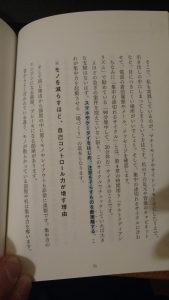
DaiGo’s 自分を操る超集中力. I highly recommend this book.
Take the following sentence as an example:
鈍色に光る剣尖が、俺の肩を浅く抉った。
Rough translation: “The shining, dark grey sword tip lightly gouged my shoulder.”
For a beginner student, who hasn’t studied kanji, this is going to be impossible to understand.
To be able to fully understand the sentence you need to know each of the parts that build it up, so let’s take a look at what they are in English first before seeing how Remembering the Kanji helps us.
鈍色 – dark grey
に – grammatical particle
光る – to shine
剣尖 – tip of a sword
が – grammatical particle
、- Japanese version of a comma
俺 – I; me (male)
の – grammatical particle
肩 – shoulder
を – grammatical particle
浅く – shallow, light
抉る – to gouge
。- Japanese version of a full stop
Putting the grammar stuff aside, if we take all the kanji and focus on their meanings given to us from Remembering the Kanji then we get:
鈍 – dull
色 – colour
光 – ray
剣 – saber
尖 – sharp point
俺 – myself
肩 – shoulder
浅 – shallow
抉 – gouge out
To get to a level where you can read the original sentence, you need to work from the ground up, but you won’t be working towards just understanding this one sentence, you will be working to understand almost the entire Japanese written language.
You will be aiming for Japanese reading fluency, not just being able to manage the example sentences in a textbook.
To do this you will want to do the following steps.
- First, using Remembering the Kanji, you need to learn all the kanji meanings.
- Then you can go on to learn the kanji words that contain more than 2 kanji such as 剣尖 and 鈍色 through reading tonnes of real Japanese and via sentence mining (which I will go into in more detail in another post but for now here’s a video on how to do it with anime, TV shows and films with a technique I like to call “Sentence Banks”).
- During the reading stage you will also learn the grammatical parts and how it is all read/said. This will mostly be picked up by doing enough reading but you may wish to use a grammar guide such as Tae Kim’s in order to help you understand grammar.
Once you have learnt 3000 characters via Remembering the Kanji, when you see these characters in Japanese text you will be able to recognize them as their English meanings, giving you a helping hand when reading Japanese.
This means that you will be able to read things like manga, JP subtitles, books with furigana etc.
If you then read enough Japanese (around 2 million words, maybe slightly more?) you should find yourself at a very comfortable reading level.
This is exactly what I did and I now have very few difficulties reading Japanese books.
Unfortunately there are no other ways of getting to this level of reading ability quicker than by actually reading a lot of Japanese in the first place.
One way or another you are going to have to read a lot of Japanese to be able to understand written Japanese. Listening works exactly the same. No amount of time spent on duolingo or studying with Genki is going to solve your reading illiteracy. The only thing that will is actually reading Japanese.
Having the knowledge of kanji meanings is also a super valuable tool that will serve you well throughout your Japanese studies as it will allow you to understand the meanings of more complex words even in the higher stages of learning the language as I mentioned earlier.
In the previous example, let’s assume you know that 剣 means “saber” and that 尖 means “sharp point”. I think it’s pretty obvious then that 剣尖 means “sword tip”.
From here all you need to do is see 剣尖 enough times in manga, subtitles, books with furigana or study the word via sentence mining to memorize its reading of けんせん.
Once you have also learned kana, and get how the basic grammar particles work, you can start reading Japanese that has furigana.
Furigana is basically kana which is used to tell someone how a kanji is read and is often displayed above the kanji.
It is often used in manga, books for younger audiences such as よみもの, or for really difficult kanji that most people can’t read.
Yes, there is a surprisingly large amount of kanji that Japanese people can’t read.
So once you’ve finished Remembering the Kanji all you have to do is read a lot, which is presumably why you are learning kanji for in the first place, to learn to be able to read Japanese.
While I will go into this topic of “how to learn to read Japanese” in a separate post, I will briefly say here that;
“to become able to read Japanese, one must first read lots of Japanese.”
No Japanese native was born “fluent in kanji”.
Every native that can read kanji has seen and read enough kanji throughout their daily lives that they have gained an intuitive knowledge of their meanings and readings.
Native English speakers are no different.
You wouldn’t have any hope trying to read the bible as a 3 year old child because you wouldn’t have even learnt the alphabet yet, let alone the type of vocabulary that lies in such an ancient text.
However, over time and massive exposure over the years, you’ve gotten used to written English enough that you can now read it to a “native level of fluency”.
This is how we learn to read and as a result you have to do the same for Japanese.
The more you read, the more readings for each kanji you will see and, given enough exposure to these words over and over again, you’ll internalize their readings, nuances and usages (as well as any grammar) until you get to the point where you can not only read full adult Japanese with no furigana, but you will also become able to produce correct, written, adult Japanese without any issues just like you can when writing in English.
So how can you learn kanji in a way that allows you to develop these skills, and how can you do it in just a few months?
Well before we get into the “how”, I want to make sure that you are aware of some “not as good methods” so that you don’t end up wasting your time using these…
Ways to Learn Kanji Inefficiently
These methods come from all sorts of sources and they are all taught with good intentions, it’s just, well, they quite simply suck.
Some of these methods may be good for Japanese natives, but that doesn’t mean they are good for you. Japanese natives already know Japanese so for them it’s much easier to learn kanji as all they have to do is attach “sound” to “character”.
Unfortunately if you do not yet know how to speak Japanese then you have to go about this differently. I therefore highly recommend that you do not follow any of the following strategies.
- Writing each character out stroke by stroke
This is how Japanese natives learn kanji at school and is probably what they will recommend because it’s all they know.
Well guess what, this method works, but it takes 10+ years.
I don’t know about you but ain’t nobody got time fo dat!
Besides, how are you supposed to learn the meanings, readings and vocab using this method? If you don’t know Japanese then it’s a waste of time.
- Learning every possible piece of information about 1 character before moving onto the next
This is one of the most common routes that people go down, especially if they take classes.
This is the same as learning them stroke by stroke, except it’s going to take you even longer.
Not only do you have to learn the stroke order but you also have to learn everything else about the character, such as all possible onyomi and kunyomi readings, as well as any other random readings, the meaning of the character as well as all the majority of words that contain that character.
Not only are you doing this out of context, which makes it all really hard to memorize, but you are wasting so much time on information you don’t need e.g. rare readings and vocab words.
I’m not saying that this method doesn’t work, because it does, it’s just really, really, really, really slow.
- Learning characters as wholes
Kanji aren’t just random squiggles. They are made of separate parts. Learning these parts first makes learning kanji a lot easier and speeds up the process.
You also shouldn’t learn characters as whole characters because there are characters that look very similar, and unless you have learnt the particles and how to write each character, then there’s a good chance you won’t be able to tell the difference between characters that look very similar.
This is because the brain memorizes the outline of the character so when you see 緑 you could very easily confuse it with 縁 because they look very similar in shape.
This isn’t a massive problem as it doesn’t happen that often but it does mean that you might occasionally read words wrong and you will also be unlikely to hand write characters.
- Not learning how to write kanji
Learning to write kanji will solve the issue I mentioned above where you may not be able to tell the difference between two characters.
This is because you associate the stroke order with the shape of the kanji and effectively take more notice of each character when you read them.
So when 緑 and 縁 come up, because you know how each one is written, you can figure out which is which and not get confused.
Also, if you don’t actually learn how to write by hand, by actually practicing writing out each character, then you won’t learn how to write.
I thought that I would be able to do this originally and that if I just learnt how to “read” kanji then I would naturally be able to write them eventually.
This is not the case.
This is because our ability to recognize something does not help your ability to recall it.
Take for example your mother tongue.
There will be plenty of harder words that you may not see very often and although you may be able to recognize them when reading, if you where to try to spell them from memory then there’s a good chance you won’t be able to.
The same thing occurs with kanji and is an emerging issue in Japan as the modern generation are writing less by hand and more so via phones and computers, meaning that a lot of natives themselves are starting to forget the “spelling” of some of the rarer characters.
If you don’t learn how to write characters then you can still get really good at reading Japanese but when you actually try to recall a character from memory, instead of seeing the character clearly in your mind’s eye with all the strokes, it’ll be more like a vague outline of the character as you can’t entirely remember all the parts that build it up.
Now of course, a lot of people will argue that not being able to write kanji by hand isn’t a huge problem in this day and age as everyone relies on technology at work and in the rest of daily life.
I also agree to some extent, writing by hand HAS become a thing of the past.
However, if you are considering living in Japan then not being able to write by hand could be very inconvenient for you.
Here’s a few examples:
- Not being able to quickly write down notes to share with coworkers.
- Not being able to fill out various forms e.g. tax forms, hospital paperwork etc.
- Having Japanese people mock you for not being able to write.
So if you don’t want to be at a disadvantage then I highly recommend that you learn to write kanji as well. Don’t worry though, I will go into how to do this later in this post.
- Learning the readings of kanji out of context
Learning a kanji’s readings out of context isn’t effective at all.
Your brain needs something to connect the information to and if you are just rote memorizing then this is going to make the whole process incredibly painful for you.
Trying to learn too many pieces of information at once isn’t playing to the brain’s memory.
It’s much easier on your brain to learn parts of kanji one step at a time as it reduces cognitive load and allows you a better chance to get readings, and other information, into long-term memory.
Learning things in this way is called cognitive chunking which is literally the process of combining individual pieces of information together to make a meaningful whole.
This is why math geniuses are so good at working out complex problems. They have mastered the basics of math and can then use these “chunks” and apply them to much bigger problems to quickly and easily solve them.
- Use loads of different methods
While you can learn kanji through different methods, most of them don’t stand up to the efficiency of the one I am going to introduce to you today.
In fact, you shouldn’t use other methods with Remembering the Kanji as even Heisig says in book 1, “What may not be so apparent is that using it to supplement the study of kanji in the classroom or to review for examinations has an adverse influence on the learning process. The more you try to combine the study of the written kanji through the method outlined in these pages with traditional study of the kanji, the less good this book will do you. I know of no exceptions.“
So if you can, try not to combine this with any other methods.
How to Learn Kanji in 3 Months
I spoke about it earlier, but Chinese students have such a huge advantage compared to those of us who don’t know a language that uses Chinese characters.
The reason being is due to the way your brain organizes information. It’s easier for your brain to build upon and learn about stuff that you already have some knowledge about than it is for it to learn something entirely new.
Here’s a great example from MattVSJapan’s video on this topic.
He takes the word apple and gives it an extra slang definition to mean “an attractive female“.
He also takes a new word that he’s just made up, “zorolla” and gives it the same meaning.
He then has an example sentence for both.
“Damn, what an apple.“
and,
“Damn, what a zorolla.“
Of course, in this case the slang version of apple is going to be much easier to remember because you don’t have to create an entirely new space in memory to remember it.
You simply add this new definition onto “apple” and your brain has remembered it.
Easy peasy.
When it comes to “zorolla“, because it’s a word you’ve never heard of before, it means that your brain is going to have to work a little bit harder in order to store the word into long-term memory.
Not only does your brain have to create an entirely new space in memory for this new word, but it has to also store information about the word’s pronunciation, its spelling and its meaning.
As you can see, that is a lot more work and this is why Chinese students have such an easier time when learning to read Japanese, because they already have something to work with and they aren’t learning from scratch.
So how can we apply this to learning kanji?
Well, it turns out that Remembering the Kanji, or RTK, teaches kanji in a way that allows us to get on the same level as a Chinese student studying Japanese. This in turn will give you a massive head start into reading Japanese.
How Does Remembering the Kanji Make This Process So Easy Though?
All the characters that you are taught in Remembering the Kanji are given a special order in which to learn. This is based on the primitives that make each character up.
This is different to what is taught in Japanese schools where the meaning of characters is the main factor that determines the order in which they are learnt.
This is because teaching characters that represent concepts that children do not yet have knowledge about is completely pointless.
For example, it is much easier to teach a child 牛 (taught in grade 2, meaning “cow”) than it would be to teach them 肝 (taught in junior high, meaning “liver”), as most kids that age aren’t going to know what a liver is.
However, just because a character is difficult to write doesn’t mean that it won’t be taught to kids. Children have amazing memories and can easily remember how to write really difficult characters.
Providing the meaning of the character is simple, children don’t tend to struggle. As they grow older and gain more knowledge, kanji with more complex meanings are introduced into their homework.
This is fine for the kids of Japan, but you aren’t a Japanese child.
If you are reading this then there’s a good chance that you already have a good grasp on these more complex concepts, so learning kanji in the same order as Japanese children do won’t be the most efficient way for you to learn them.
Not to mention our ability to memorize stuff sucks in-comparison to a child’s, so we are going to need to make things easier for ourselves.
What’s The Best Order Then?
As an adult then, we should prioritize the primitives that make up each character over their meanings instead.
Why do this?
Well it’s pretty simple.
Take for example 工, meaning craft. It’s obvious that this is a much more complex concept than 雨, meaning rain.
In Remembering the Kanji, 工 (craft) is the 80th character taught and 雨 (rain) is the 451st character taught. This is due to the complexity of the building blocks that make up the characters and not their meanings.
In other words Remembering the Kanji focuses on the “primitives” of characters first and teaches you the characters in an order that means that, when you learn a new character, it will merely be a combination of characters that you already know.
Again, this plays to our memory as it allows us to just “chain” information to previous knowledge, making it much easier to remember new characters.
Here’s an example:
If you remember from earlier, we already know that 工 means “craft”.
Let’s assume you that you also learn the primitive (not character) for “water” which looks like this: ⺡
Now propose that 江, meaning “creek” comes up for you to learn.
Already knowing ⺡ and 工 now makes learning 江 so much easier as you can relate it to information that you already know.
The order in which kanji are taught in Remembering the Kanji has been created in this way to make the whole process a lot faster, and it makes learning characters like 構, 腸, or even 鏨 a piece of cake.
It also means that some really difficult to write characters are taught earlier on and that some really easy to write characters are taught near the end.
But this is done for efficiency, and let’s face it, you are going to need to know, almost, all the kanji taught in Remembering the Kanji, so why not learn them all in the most efficient manner?
Yeah, this does mean you are going to learn some rarer kanji before more common kanji, but doing it this way saves you sooooo much time in the long run.
I mean sure, 肖 is rare to see in text, but why learn 削 before 肖, just because it’s incredibly common, when it’s easier to learn 削 by already knowing 肖 and ⺉?
It’s much easier on your memory and you are still going to want to know 肖 for a whole load of other characters as well such as 梢, 哨, 消, 鞘 and many others..
?・ ?・?・?・?・?・?・?・?・?・?・?・?・?・?・㲖・?・㲵・?・?・?・?・?・?・?・?・?・?・?・䇌・?・?・?・?・?・?・?・?・䏴・䘯・䨭・䴛・俏・削・哨・娋・宵・屑・峭・帩・弰・悄・捎・旓・梢・消・焇・琑・痟・睄・矟・硝・稍・筲・綃・绡・艄・莦・蛸・誚・诮・趙・踃・輎・逍・銷・销・陗・霄・鞘・韒・颵・髾・魈・鮹
But wait, there’s more to Remembering the Kanji than just the order in which you learn them…
Mnemonics
To REALLY get these characters firmly stuck into your long-term memory, we are going to use an incredibly powerful mnemonic memory technique known as the Story Method that’s also introduced to us in Remembering the Kanji.
Now you may be wondering, what’s a mnemonic?
According to the Oxford Dictionary, a mnemonic is “a system such as a pattern of letters, ideas, or associations which assists in remembering something.”
To put it simply, a mnemonic is a learning technique that helps aid information retention.
There are a few ways that we can apply mnemonics to Remembering the Kanji in order to help make really memorable stories that will allow us to not only remember the meanings of each kanji but also how to write them as well.
The Story Method
The story method is the main mnemonic that Remembering the Kanji uses to help us solidify kanji into long-term memory, and it’s really simple.
All we have to do is create a story that relates the meaning of a kanji with the meanings of all the parts that make it up.
If we take the example from just a minute ago we have the keywords “water”, “craft” and “creek”.
You can see then how a short story like, “given enough time, running water will naturally craft a creek.” will help you link the two components, as well as the new character, together while making it super easy to remember in comparison to rote memorization.
A Note About The English Keywords
Before we get into “the how” of this method, I want to quickly discuss the English keywords used in Remembering the Kanji.
In Remembering the Kanji every character is given an English keyword that, for the most part, is related as closely as possible to that characters true meaning in Japanese.
The reason that we use English keywords is because we don’t know Japanese yet, so it’s going to be impossible for us to use keywords that act as a cue to remember the character when those keywords are in Japanese.
It just doesn’t make any sense to do this.
However, due to the fact that some kanji can have several meanings in Japanese, and that some kanji can have similar meanings when translated into English, not all of the keywords used in Remembering the Kanji are perfect.
A rare few have very strange meanings and these are particularly annoying to learn.
In fact, I learnt a few new English words when doing Remembering the Kanji.
However, these keywords, according to Heisig himself, have been “carefully chosen and should not be tampered with if you want to avoid confusion”.
The reason Remembering the Kanji does this, is to reduce memory interference when learning similar kanji.
The worst thing you can do is confuse two similar characters with each other. This would make it incredibly hard to learn and remember them both.
So just bare in mind that not all the keywords are accurate but that this is done on purpose.
・・・But 3000 Chinese Characters in 3 Months? How is That Even Possible?
Okay I totally get it, you still don’t quite believe that it’s doable.
Yeah, it seems impossible to learn 3000 characters in 3 months, even if we are focusing purely on their meanings and how to write them.
But it is completely feasible, I just haven’t mentioned our secret weapon up until now that’s going to change everything…
That’s right, this method isn’t just built upon simple memory techniques and a little bit of logic… oooohh no!
Introducing our 秘密兵器: The SRS
In case you haven’t heard of Anki, or Spaced Repetition Systems, before then I will briefly explain the concept for you.
There’s also this great video that sums up the concept of spaced repetition in about 4 minutes.
To put it really simply, spaced repetition systems/software, like Anki, are generally flashcard applications that help you memorize huge quantities of information super easily while also allowing you to actually keep it in your long-term memory.
This is done by learning and reviewing information in flashcard form while also spacing the reviews of these flashcards out in the most efficient manner possible.
Let’s take Anki as our example as it’s what I use and it’s one of the most popular pieces of software out there as it’s completely free.
At a first glance, Anki just looks like a simple flashcard app but it has so much support for various different content that you can learn anything with it and not only that, but in a way that will make your traditional study methods look pathetic in comparison.
I know people who use it for math, medicine, people, place names, and obviously language learning, among many other topics. It can be used to learn and memorize literally anything.
Anki is incredibly efficient compared to traditional study methods
But why?
Anki implements spaced repetition in order to organize your flashcard reviews.
So instead of spending everyday going through the same set of flashcards, Anki will make a very good educated guess (which gets even better upon more feedback from you) as to when you are going to forget those flashcards.
When you learn something new you are going to need to review it often so that you can keep remembering it.
As time goes on, you won’t need to review it as much.
This means that you can continue to learn new information as you continue to remember and review older information.
Not only is this really efficient as it allows you to spread out your work load and thus get more done, but it’s actually better to do this as reviewing information just as we are about to forget it makes it stick really well in long-term memory.
Here’s a graph to help you get your head around it.
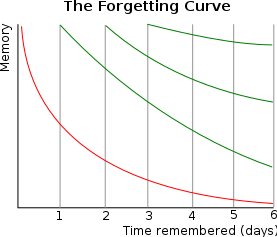
From this normal forgetting curve you can see that after learning a new piece of information you are likely to have forgotten 50% of it after 1 day and even more so within 2, 3, 4, 5 days etc.
Now this isn’t a normal spaced repetition forgetting curve so from this graph you can only see how memory works by reviewing information everyday.
If you take a look at this spaced repetition graph though, you will see that the days when you get reminded are spread out further yet retention rate is kept above 90%.
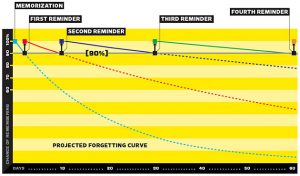
If you want to know a bit more about the process behind the SRS then this article is a good start: Want to Remember Everything You’ll Ever Learn? Surrender to This Algorithm.
This is what Anki does for you.
It automatically spaces out your reviews in order to optimize your learning, giving you way more free time. Which you can use to learn even more!
If used correctly, you can use an SRS to not only learn and remember 3000 kanji in 3 months but you can go onto memorize entire phrases and sentences in Japanese in order to use them yourself, and you won’t forget them.
Well 90%+ of them anyway…
Now while I say “you won’t forget them”, the SRS and us humans aren’t perfect.
You have to go about creating these flashcards in the right manner otherwise your brain isn’t going to work with you. This is fine though as I am going to show you exactly how I, and many other language learners, use/used Anki in order to learn kanji.
If used properly Anki can easily get your retention rate into the 90%+ range for almost any piece of information, which is incredible if you think about it.
There’s no other tool that I know about that can promise that kind of retention.
(If you know of one please tell me about it.. :p)
If you therefore combine Anki AND mnemonics to learn kanji, via Remembering the Kanji, then it’s going to be a piece of cake.
Don’t be afraid of using Anki. Sure it may be new to you but it’s actually really easy to use and I am going to show how to do everything so that you can efficiently learn all the kanji!
So let’s get into it!
How to Learn Kanji with Remembering the Kanji and Anki
This part of the post is going to be split up into stages which I will number to make it easier for you to come back to. I’ve done this just in case you get distracted and get pulled away from your studies.
If you need to go back to a specific step quickly then press CTRL+F and search “Step 1” or “Step 2” and press enter to jump to the right section.
If you haven’t already done it, I would also recommend either bookmarking or dragging the URL of this page to your desktop so that you can easily come back to it later.
I’ve also made a video showing you how to do this part of the process. It covers most of what you need to do.
Step 1: Downloading Anki and Setting Up Your Remembering the Kanji Flashcard Deck
Okay so first things first, if you haven’t already got it, go and download Anki by clicking here.
Anki is a very powerful piece of software and has a large user manual, so if anything goes wrong then there’s a good chance that your answer is someone in there. There is also a help page that also links to some introduction videos and other support pages that might be worth checking out especially if you are a complete noob to Anki.
If you can’t figure it out then you can also leave a comment here or check out the anki subreddit or the kanjikoohii forums where you will find people who can help you.
Once you have downloaded and installed Anki, open it up and you should be faced with a box that looks a little something like the one below, although yours might not be in Japanese and it may look slightly different as I have various add ons/plugins installed. If you are interested the plugins that are available for Anki then you can find a post I made on them here.
(It takes too much effort to change the language back to English so bare with me throughout this tutorial and in fact I would recommend you put it in Japanese from word go so that you get even more exposure to kanji anyway :p).
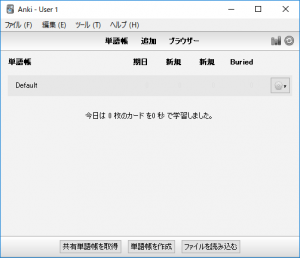
Once you have installed Anki you are probably going to want to create an account.
One of the brilliant things about Anki is that your data is stored on Anki’s servers and can be accessed by any device that you have that has Anki installed.
All you have to do is sign in with your account, hit sync, and you can continue where you left of on your PC while on the bus using your iPhone. このアプリ便利だね!
To make an account you just need to go to the top right part of the app and click on the symbol that represents “sync” that is situated next to the “graph” icon.

Doing this for the first time will open up a sign in window. Click the “make an account” (登録) link, follow the instructions to make your account, and you should be ready to go.
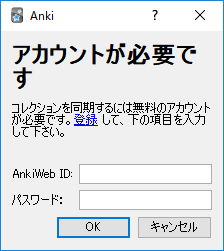
After you’ve made an account the “sync” button will be used to sync your data with Anki’s servers. Once you’ve finished studying for the day, it’s always worth either closing Anki (which will initiate an automated sync) or manually syncing yourself by pressing this “sync” button. This will prevent any data loss if your computer decides to pull a Houdini.
Step 2: Download My Remembering the Kanji Deck and Install the Kanji Stroke Order Font
To make this process super easy for you, I’ve shared with you the deck that I used to learn these characters via remembering the kanji.
This deck, so far, is probably the best shared deck available on ankiweb for Remembering the Kanji. This is because all the other decks available have loads of extra rubbish in them that you don’t need and that just gets in the way of your studies.
Mine has everything you need. Nothing more, nothing less.
The other decks for Remembering the Kanji have all sorts of extra information like readings, words, other people’s stories but all this extra information actually starts to take you away from the essence of Remembering the Kanji and will actually make it harder for you if you decide to use this extra information on your cards.
If you have the Remembering the Kanji books then it might be tempting for you to add Heisig’s stories and comments to each card.
I wouldn’t do this as it’s a much better idea to use your own stories and you shouldn’t really need his guidance after you get the gist of the process.
If you want to then by all means read through the book as you learn each character, but if I write this tutorial properly then you shouldn’t even need to do that.
Once you’ve downloaded and installed Anki, you can head over to ankiweb and download my Remembering the Kanji deck by clicking the link below.
BritVSJapan’s Super Simple RTK Deck
Once you’ve clicked the link you should come to this page:
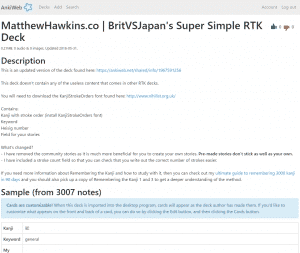
Scroll down and click the Download button.
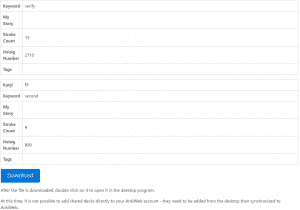
Clicking download will save the file to your downloads folder. Once you’ve downloaded it you will want to double-click the downloaded file while Anki is open and Anki should automatically import it.

If this doesn’t work for some reason then you can import it to Anki by going to File -> Import (or ファイル -> 読み込む) as you can see below:

If you do it this way then once you’ve clicked import all you have to do is find the downloaded deck file and open it like this:
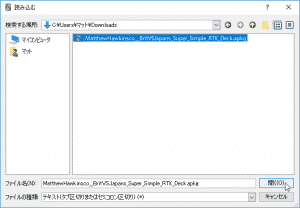
Once you’ve imported the deck, Anki will show you a little yellow alert box saying that it’s imported 3007 cards and you will now have the deck in your deck list:
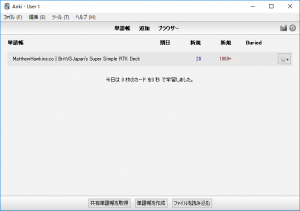
Getting the Stroke Order and Other Fonts
Before you can actually use the deck you will need to quickly install a font for the stroke order.
Note: if you don’t care about writing by hand then you can skip this stage.
I use a font for the stroke order, and not pictures, in my deck for two reasons:
- to save memory on my devices
- to make the stroke order easy to see across all my devices
There are other decks that have lots of pictures of every single stroke change which just takes up too much room on your flashcards. It’s really hard to view on your phone hence why I opted for this option instead.
While we do this we are also going to take some of MattVSJapan’s advice and install a few other fonts to show the differences between handwritten characters and characters you would see on a computer.
This way not only will you learn how to write each character out by hand, so that your handwriting looks natural, but you will also be able to recognize both typed kanji and handwritten kanji.
Just like the letter “a” on a computer is totally different to how one would write it down, written kanji can look very different to their computerized counterparts.
My handwritten, albeit terribly, “a” VS your standard Arial font “a”.
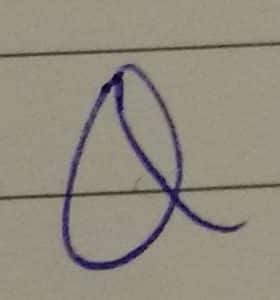

Completely different right? Well this occurs in Japanese too.
Here are a few kanji examples:


As you can see the above character for “person” is ever so slightly different when written.


This character for “heart” is written very differently.
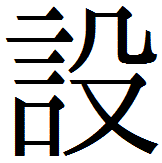
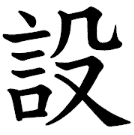
This character meaning “establishment” is ever so slightly different in the way it’s written.


And for this character, meaning “cool”, the difference between the two fonts makes the handwritten version look almost like an entirely different kanji.
Because of this, we will be installing a few extra fonts so that you can automatically see the differences for each character.
To download the 4 fonts we will be needing, head over to this link and download each font file.
To make sure that all these fonts work across all our devices we are going to need to put them into Anki’s media collection folder.
Installing them to your PC, unfortunately, won’t allow them to be display on your phone.
Once you have downloaded each font you will need to find Anki’s media folder.
Start by clicking the search bar and type in %appdata%.
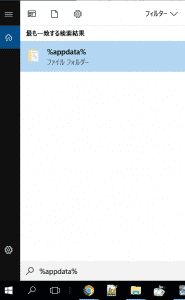
Open the folder and find Anki2.

From here you want to select the profile you are using to study Japanese, for you this should be User 1 (if your Anki is in Japanese then it’ll be ユーザー1).

When you open this folder you will see a directory called collection.media. This is where Anki saves the media files it uses for your flashcards. If you added a picture or a piece of audio to a card then this is where Anki would store it so that it can access it when you do your reviews.
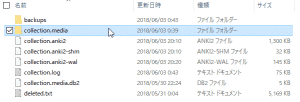
Open the folder and, unless you have any other decks, it should be empty.
From here you just want to copy all 4 font files over to this folder. Be warned though, do not change their names otherwise Anki won’t be able to access them and they won’t display on your cards.

If you aren’t bothered about using these fonts on other devices then you can simply just install each font to your PC one at a time.
To do this open the files by double clicking on them and you should see the following window pop up.
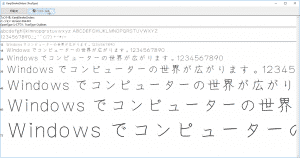
From here just click the install button (in my case インストール) and your PC will install the font.
After you’ve installed the fonts, Anki should display the stroke order and the other fonts perfectly fine.
You can check to see if they are working by opening the deck up in Anki, clicking the “Study Now” button, and after pressing the space bar to show the back of the card, you should see something like this:
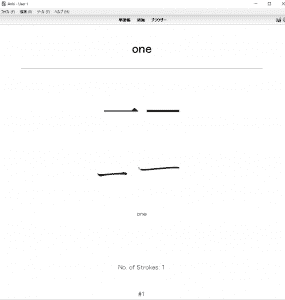
If you can see the character for “one” with a small “1” next to it then that means that the stroke order font is working correctly.
You should also see a difference between the other 4 copies of the character. Take note of their differences and remember that the first 2 are how you will see printed characters in books or on a computer and the bottom 2 are the closest you will get to handwritten Japanese.
Step 3: Understanding the Card’s Layout
Before we progress, I want to make sure you understand the cards layout and how to edit anything if you need to.
For the most part you should only ever need to add or edit your stories and you shouldn’t need to change any other parts of the card but it’s useful to know what each part means just in case.
There are three windows I want to introduce to you here, the first is the “Edit” (編集) window which is the one you will be using to enter your stories into.
You can access this window by pressing the “E” button on your keyboard while studying a card.
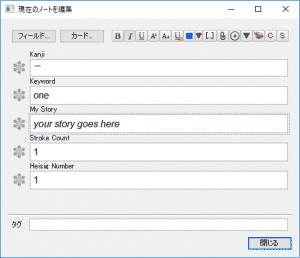
What Each Field Does
As you can see we have 5 fields with different things in them.
- Kanji
- Keyword
- My Story
- Stroke Count
- Heisig Number
The first field, Kanji, is where the character you are going to learn goes. Unless you are learning extra kanji once you have finished, you can leave this field alone as it should be filled for you.
The Keyword field, again, is something that you don’t want to touch. Heisig has given each character a specific keyword for a few reasons which I mentioned earlier and this is for your benefit, so don’t change this field.
The My Story field is where you want to type in the story that you’ve created for this specific character. More on how to make really awesome stories in a bit.
The Stroke Count field is just a simple field that tells you how many strokes it takes to write the character out. This is so that you can check that you’ve written the right number of strokes when you finish writing a character out from memory.
And finally we have the Heisig Number. This is here so that, if you need to, you can easily refer back to the character in Remembering the Kanji. It also acts as a great motivation boost as you can see yourself gradually easing your way through the kanji day by day.
So let’s take a look at how each of these is displayed on our card.
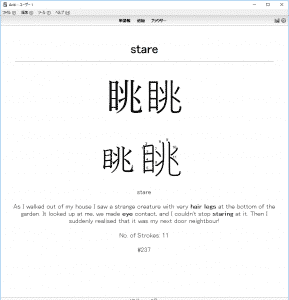
The first thing we see is the English keyword on the front of the card.
Therefore our task is to try to recall the kanji from memory, using the English keyword as a cue.
What should happen is that they keyword should trigger you to remember the story and from the story you should be able to remember the kanji and how to write it by hand.
If you then press “Space” to show the back of the card, we can see the rest of the information.
All this information is on the back for a reason and you shouldn’t put them on the front. You may want to switch the Keyword and Kanji around if you don’t want to learn how to write by hand though. I will talk about this in-depth a bit further down this post.
The first thing you will notice is that we have 4 different fonts of the same character. As mentioned before, this is so that you can tell the different between printed Japanese and handwritten Japanese. Most people don’t do this and end up learning how to write kanji from printed fonts which looks a bit strange and unnatural.
The first 2 fonts are printed fronts and the bottom 2 are handwritten fonts. Copy the bottom 2 fonts when doing handwriting practice.
The next thing you will notice is the keyword being display once again on the back of the card. I’ve done this out of personal preference and you don’t really need it but it just saves you having to scroll up to the front of the card if you ever need to check the keyword again.
The next section is for your story and by default will be blank. To add your story press “E” on your keyboard and type it into the “My Story” field.
After the story you should see the number of strokes it takes to write the character, use this to check you got the amount of strokes correct when writing the kanji.
And right at the bottom we have the Heisig number.
In my opinion you don’t need anymore information than this and if you really wanted to then you could even get rid of the Stroke Count and Heisig Number fields if you want to make it even simpler.
Understanding the Stroke Order Font
If you take another look at the previous flashcard for the kanji “Stare” (眺) you can see the stroke order font tells you not only in which order you should be writing each stroke but also in which direction as well.

Where the number is located is the starting point of where you need to write and you always write away from that number, so stroke 1 goes downwards, stroke 2 goes from left to right and then curves and goes downwards, stroke 3, 4 and 5 both go from left to right and so on and so forth.
Pretty straightforward.
You will also notice that you will have a “number of strokes” section which tells you how many total strokes it takes to write the character. This is because you should ALWAYS count the strokes of each character as you write them and then check against the number given on the flashcard aftwards.
Step 4: Change Anki’s Settings for Optimal Study
For this section we are going to change the default Anki settings slightly in order to make our study a little more efficient.
First head to Tools -> Preferences (ツール -> 設定) just like in the screenshot below:
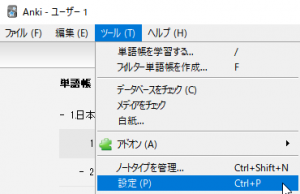
This should open a new window. From here you can change a variety of Anki’s settings.
While making this post I realized that Anki has finally added a setting that easily allows you to change the language settings but I’m going to keep mine in Japanese to give you more exposure to the language (plus I can’t be bothered with going back and taking all those screenshots again 笑).
I also seriously recommend that you put Anki, your OS and any other software/websites/apps you use into Japanese from day 1 so that you can start picking things up straight away.
On the first tab we are going to change the second drop down menu from “Mix new cards and reviews” (新規カードと学習カードを混ぜる) to “Show new cards after reviews” (復習カードの後に新規カードを学習する).
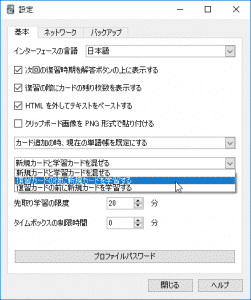
The reason for doing this is to make sure that you review all your cards before learning any new ones.
Anki optimizes your review schedule so that information that you have already learnt will be displayed around the time you are meant to forget it, therefore making sure that you do all of your reviews everyday is incredibly important otherwise you will forget what you don’t review.
As a result it’s best to apply this setting so that you make sure you finish reviewing what you have already learnt before you start learning any new cards.
As long as you do this you shouldn’t lose any progress even if you don’t learn any new kanji.
As I just mentioned, it’s incredibly important that you make sure you do all your reviews so the next thing we are going to do is change the default settings for how many reviews and new cards you can do per day.
To do this then we are going to need to change your decks settings. To access your deck settings click on the cog icon, which is to the right hand side of your kanji deck, and then click “Options” or “オプション”.

The deck options window should look something like this:
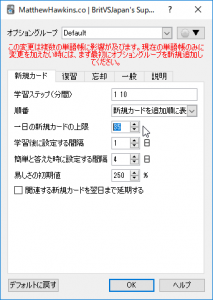
To get all 3007 kanji done in 3 months/90 days you will need to learn 34 a day so let’s change “New cards/day” (一日の新規カードの上限) to 35, which gives us a little bit of leeway.
Once you’ve done that go to the “Reviews” (復習) tab.
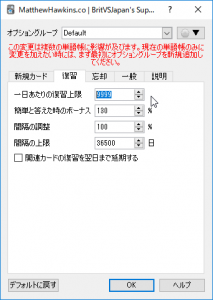
From here we are going to have to change “Maximum reviews/day” (一日あたりの復習上限) to the max value it can possibly be which is 9999.
While it’s highly unlikely that you will ever reach this many reviews per day, you will definitely go over the 200 default limit that Anki sets and if you don’t do all your reviews everyday then you are literally forgetting a lot of what you have already learnt, making Anki useless.
A lot of people don’t realize that this setting exists and that Anki is actually limiting their reviews each day. As a result they get the same results that people who know about, and have changed, this setting do.
I still have no idea why this is a default setting as it defeats the point of study with Anki but hey ho, at least you know about it now so that you can change it.
The next thing we want to do is go to the “Lapses” (忘却) tab.
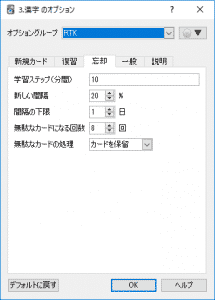
For the most part you want to leave these settings like they are but we are going to change the “New interval” (新しい間隔) setting to 20%. This means that if you fail a card then it won’t get completely reset to a “new card” that you have to learn again from scratch. This is just a little bit more efficient to do than to learn all your incorrect cards again from zero as it’s very rare that will completely forget a card.
Once you’ve changed these settings then you can leave the rest alone and you can start learning kanji.
Step 5: Start Learning Kanji
Bare in mind that my Anki will look different to yours as I have plugins installed, if you click on the deck name then you will be shown the following screen:
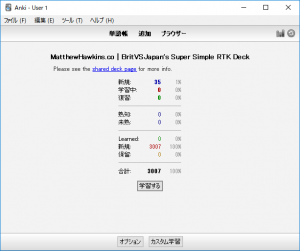
From here you can click the “Study Now” (学習する) button to start your studies.
Doing this will show the first card which is the kanji for “one”.
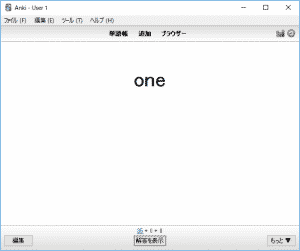
Clicking the space bar, or the “Show Answer” (解答を表示) button, will show you the back of the card where you will find your story that you’ve created for the kanji as well as the stroke order and stroke count.

Obviously at this point we have yet to make a story, so quickly take a minute to create one and once you’ve done that press the “E” button on your keyboard to edit the flashcard. Doing so will display the following window:
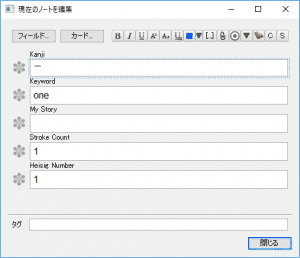
From here we are going to want to enter your story. This kanji is way to simple for creating a complex story for so we are just going to go for something simple.
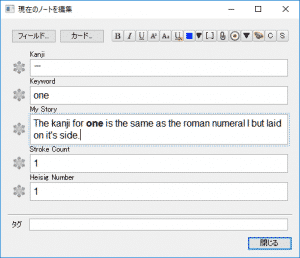
After entering your story you can click “Close” (閉じる) and then show the back of the card again to see the story.
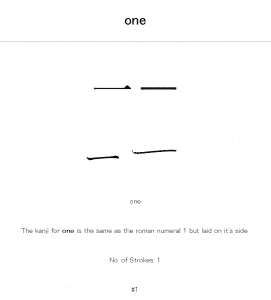
As you can see, the story now appears on the back of the card.
After you have made your story, and written the character out once, you are going to want to hit the “Good” (普通) button.
Step 6: Using Primitives to Create Your Mnemonic Stories
Now at the early stages there are going to be a lot of primitive components to remember and this deck doesn’t include them as they aren’t really worth putting into your flashcards.
If you read the Remembering the Kanji book as you go through your studies then Heisig will tell you the primitives as you come across them. He will give you primitives, along with corresponding keywords, and you will then use them to create a story for the character you are learning.
If you don’t have Remembering the Kanji then you can use the list found here as a reference for all these primitive components.
It might be a good idea to learn the primitives that Heisig uses as well. This isn’t entirely necessary but it will speed up the process for you. If you are interested in learning the primitives first then you can download my RTK Primitive Deck here.
BritVSJapan’s RTK Primitive Deck
Unfortunately the primitives won’t display properly in Anki so to make this deck I had to take screenshots from the website I shared above. This means that you won’t be shown the stroke order or the different fonts like in my main deck. You can learn all this when you do the Remembering the Kanji deck though so don’t panic.
Before you start Remembering the Kanji it might be worth to completely go through this deck. However, you can always go through it while you do the Remembering the Kanji deck as well.
I personally never used a deck like this and just picked up the primitives when learning each kanji, so it’s not really necessary, but I can see how it can make the process a lot easier for you.
As I said before, chunking information into smaller pieces makes it easier on your brain.
Get Crazy With Your Stories
When going through my Remembering the Kanji deck, I strongly advise making your stories as abstract and “out of the ordinary” as possible as this really helps them stick.
Try to really picture the story as well, focusing on attention to detail as well as on the keywords in order to really help you remember the story in the future.
Having the keywords link in weird ways can also really help you to remember characters, for example take 森 (forest) which is made up of 3 copies of 木 (tree), you could picture 3 MASSIVE trees in the middle of a normal forest. Really picture the 3 trees being as tall as the sky itself and you will have a hard time forgetting 森.
You can also use curse words or rude situations which work amazingly well in allowing you to remember these stories.
Consider the Locations of Primitives to Aid Handwriting
When making your stories it can also be a good idea to think about the location of primitives and somehow try to include these into the story as well.
By doing this you allow yourself a better chance at remembering how to write each character.
This is especially useful for more complex characters as sometimes you may forget whether a primitive goes left, right, up or down.
I’m going to use 杏 and 呆 as an example here as they are both very similar characters that mean completely different things.
According to Remembering the Kanji:
杏 means “apricot” and,
呆 means “dumbfounded”.
As you can see they are both made up of the same primitives, 木 (tree) and 口 (mouth), but if you where to use one in place of the other, it’d be very confusing for anyone attempting to read it.
While a Japanese person may notice your mistake and correct you, you will still feel enough shame to want to 切腹.
So to prevent this happening let’s use direction in our story to allow us to remember where each primitive lies.
A good story for 杏 then could be: “I sat under the tree with my mouth open waiting to catch the giant, juicy and deliciously looking pink apricots.”
And a good story for 呆 could be: “I just saw an idiot hanging down from the very top of a tree using nothing but his mouth! I was completely dumbfounded!”
In these two instances I didn’t directly link the direction with any of the “mouth” parts in either story but instead to the person that appears in the story.
In both stories the person’s mouth is being used and as long as you remember the placement of the person in the story then this gives away the placement of the mouth primitive.
As both characters are simple enough, I didn’t need to add in any extra information to give away where the tree part is.
By doing this, when you come to write out the character by hand, if you ever forget how to write it then you can just recall the story you made and the hints in the story will tell you where each primitive should be.
You may also have noticed that I added a lot of adjectives in the first story. This is to allow you to really paint a strong picture and to get you really focusing on it. Adding extra information like this improves your chances of remembering the whole story and thus the character that links with it.
While these two example stories are relatively short because the characters are simple, for other characters that are a bit more complex it might be worth creating longer stories.
Heisig also recommends creating longer stories when you start out in order to stress the importance of recreating a fully detailed, complete picture in your imagination, and to ensure that you do not merely try to associate words with other words, but with actual images.
Other Tips and Solutions to Common Issues
Be sure to give yourself enough time to really picture your stories in your head.
You will know that you are NOT giving yourself enough time when you find yourself memorizing the keywords instead.
At first it may seem difficult and you may feel like you want to learn more characters instead of focusing on the stories of each one in order to save yourself time, but by doing this you will actually waste more time in the long run.
The process does get easier with time.
As it does get easier it can also be more tempting to skip over stories more quickly as well.
When learning a new character you should try to spend a good few minutes on each character by focusing on the locations of the primitives, creating a small story and writing the character out in the correct stroke order.
By doing this you will not be wasting time but you will in fact save yourself the time it will take to relearn them later.
When I first went through Remembering the Kanji, I never practiced writing the characters out by hand. As a result, even though I successfully managed to learn how to read Japanese, I couldn’t write Japanese by hand at all.
For a long time this didn’t bother me but after a while I decided that it wasn’t good enough that I couldn’t write by hand.
I therefore had to restart Remembering the Kanji in order to learn how to write the characters.
Even if you currently don’t care that much about writing kanji by hand, and you just want to learn how to read them, I would still recommend that you follow Remembering the Kanji to the letter and write each character out so that when you do change your mind (which I expect you will at some point), you won’t have to relearn them all again.
Another thing to note is that as you progress through the kanji, you may come across characters that have similar meanings to other characters that you have already learnt.
If you aren’t careful, your imagination could automatically add elements and see connections that could be counterproductive in the long run.
This means that there’s a chance that your previous stories or keywords could cause memory interference with any new keywords and stories that you use.
For example you might think that it’s okay to change the primitive for “old” to “old man”, or “cliff” to “cave” but as Heisig points out, these changes will be confusing when you meet the kanji and primitives with those exact meanings further on.
If this happens then you ought to return and amend those earlier keywords and stories.
If it’s a case that you’ve changed a keyword then you should create a new story from scratch to prevent confusion but if it’s a case that your story is the problem then be aware that it’s much easier to slightly change a story that has already been learnt than it is to discard the story and completely start from scratch.
There are also some other issues that people who do Remembering the Kanji have so I will quickly go through them here in case you end up having them too.
One common problem that people find is that “they can remember the keyword when they see a kanji, but they have trouble remembering the kanji when they see the keyword.”
This problem often occurs because you haven’t practiced writing out the kanji by hand.
If you try to take shortcuts by skipping the process of writing and you just recognize the characters for what they mean then you will find that you will not be able to recall kanji from memory.
You will only be able to recognize them.
By doing this you can still learn how to read the kanji but you won’t ever be able to write by hand.
Make sure you study only from keyword to kanji.
Confusing 2 different kanji with each other is also another common problem that seems to occur.
To fix this issue you should pay careful attention to both of the stories you have created.
There’s a chance that some parts of the stories cross over due to similar keywords or other similar parts of the stories.
Take this into consideration and modify your stories to prevent this kind of memory interference.
Another good way of overcoming this is to also use a word in Japanese that you know, that uses the kanji you are learning and to add that to the “Keyword” field in hiragana.
This does require that you know some Japanese already so if you don’t then you might not be able to do this.
You will want to make sure though that you don’t use the word in kanji form but in hiragana form so that you don’t see the character before trying to write it from memory, as this is cheating yourself and it won’t help you.
Make Use of Your Spatial Memory
Science has shown us that humans spatial memory is particularly “on point”. This is something that I have really began to realize more recently since starting my new バイト as a delivery driver.
For some reason, after going to a particular place once, it’s often instantly ingrained into my memory and I will very often remember exactly how to get there, without having to rely on Google maps.
It made me think back to how Mind Palaces work and so I decided to do a bit of searching online and it turns out that our spatial memory is incredibly powerful.
This is quite probably due to having to remember your way back home or having to know where an enemy tribe lives back as cave men hundreds of years ago, as this could be a question of life or death.
So implementing “space” into our stories can be a powerful technique to help boost our retention rates to even greater levels.
If you decide to do this then I would recommend that you use “spaces” that you know well, such as your home, your workplace/school, the way to work/school etc.
The more familiar you are with the “space”, the more likely you will remember it in your story and the better picture it’s going to help you paint in your mind’s eye, which in turn will help you better remember the character you are tying to recall.
If you take all these techniques into consideration, while learning the kanji, then you should get a pretty high retention rate and find it very hard to forget what you’ve learnt.
However, everyone’s imagination is different and each of us have their own advantages and disadvantages. I therefore suggest that you try to pay attention to what tricks really help you and focus on those.
If you are interested in learning how to use other memory tricks that could help then I would suggest looking into the Method of Loci/Mind Palaces/the Roman Room Method as a starting point.
Be Careful When Making Your Stories…
The one thing you do need to be careful of is the trap of not making stories for “easy” characters or not reviewing your characters properly because you “have no issue with them”.
This attitude will lead you to become lazy with the process and it will have an effect on the rest of your kanji studies.
With Remembering the Kanji you are going to want to treat every kanji the same, no matter how easy or hard. If you don’t then you will end up getting frustrated with yourself months further down the road when those “I have no issue with these” characters end up being the ones you can’t recall or recognize.
Kanji won’t learn themselves so make sure you put the effort in to learn each and everyone properly.
Don’t lapse on Remembering the Kanji and use it just for the harder characters, as Heisig himself puts it, “if you start using the method only as a “crutch” to help you only with the kanji you have trouble with, you will quickly be limping along worse than ever. What we are offering here is not a crutch, but a different way to walk.”
But What About Those Crazy Keywords That I’ve Never Heard Of Before?
For the few English keywords that you may have never even heard of before, I would suggest learning those words in English first before attempting to associate the keyword to kanji.
I have my own Anki deck for learning words in English and I recommend that you make one too.
It’s really simple, all you have to do is make a new deck in Anki by clicking the “Create Deck” (単語帳を作成) button found at the bottom of Anki’s home page.
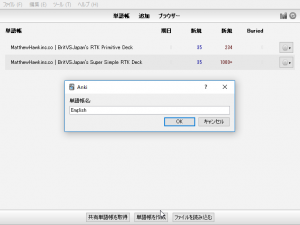
Give it a name, such as English, and whenever you find a keyword which you don’t know, give it a Google for an example sentence and its dictionary definition.
I usually lay my English cards out like this:
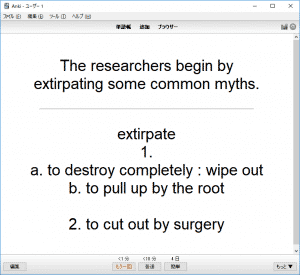
Example sentence on the front, definition of the word you are trying to remember on the back.
Nothing to difficult.
It’s all about making it easier on your brain.
For some keywords, you may have to do this to understand the keyword before learning the kanji but even then the only way you can get a full understanding of a characters’ meaning is by seeing it used in multiple contexts and situations in real Japanese.
Until you do that, then you don’t really know the character anyway so don’t worry about the English keywords not being accurate or being complicated.
You could never get a full understanding of Japanese kanji, or words either, with English translations anyway as the languages are so different.
So for now, don’t worry too much about this, just focus on getting kanji into your head, then you can start working on mastering them.
Step 7: Reviewing Learnt Kanji
The reviewing process is very simple.
When you load up your deck, providing you changed your settings like I showed you earlier, you will have to do all your reviews before you start learning new kanji for the day.
All you have to do is go through each flashcard one at a time, trying to use the keyword to remember the story you’ve created.
From there you want to picture the story briefly in your head, trying to remember all of it, and from there you should have enough information to write the kanji out from memory.
At this stage you should write out each primitive until you’ve written the entire kanji out. While doing this, keep track of how many strokes you used to write the character and try to remember which order you wrote them in.
While some people say that stroke order doesn’t matter, it definitely has an effect on your handwriting so do pay it some attention. Stroke count is way more important though, as if you miss one stroke it’ll become an entirely different character.
Once you have written the character down on paper, hit the “Space Bar” to show the back of the card and check if you’ve written the correct kanji.
Refresh yourself with the story if it was hazy for you and also check that you wrote the kanji out correctly.
That’s it, once you’ve done this, mark yourself on how well you did by hitting one of Anki’s answer buttons and move on to the next kanji.
A quick note about writing kanji out when reviewing them. There’s a chance that you’ve gotten in the habit of writing out characters multiple times during study, especially those really hard ones.
In my opinion, and according to James Heisig himself, there is no need to write out each character more than once per review. The only reason you might want to is if you are having trouble with the stroke order and you want to make sure you get a better “feel” for it.
If a specific kanji causes you any issues, and you struggle to recall it, then you need to take a look at the story as that’s where the problem lies.
Also be aware that you will need to keep reviewing your flashcards even after the 90 days it will take for you to learn them. If you don’t do this then you will lose them from your long-term memory making all your hard work a waste of time.
Grading Yourself
Anki organizes your reviews based on how well you remembered a piece of information and it needs feedback from you in order to do this.
You may have already noticed, but there are some buttons at the bottom of the program which will display “Again, Hard, Good, Easy” (もう一回・難しい・普通・簡単).
These are your answer buttons and they are what you are going to use to tell Anki how well you did.

Some people struggle to know which answer to choose as it’s hard for them to tell how well they did.
If you find yourself struggling on how to grade yourself then follow this rough guide:
- Mark all “new cards” as “Good” (普通) the first time you learn them.
- Only use “Again” (もう一回) if you have really forgotten a kanji to to the extent where you can’t even remember studying it in the first place.
- If you forget parts of a kanji or you confuse it with another kanji then press “Again” (もう一回) and think about why it was hard for you. Is it because your story isn’t that good? Maybe the keywords are too similar? Really get to the solution of the problem before learning it again and fix it, otherwise you will keep getting it wrong.
- For the majority of your review sessions you should be clicking “Good” (普通). If you aren’t, think about why, look back through this guide and Remembering the Kanji and see if there is anything you are doing wrong or have missed. If you have to remember the story before writing the kanji then that’s perfectly normal, still mark yourself as “Good” (簡単).
- Use “Easy” (簡単) for any kanji that instantly come into your head and that you can write straight away without even having to think about the story. E.g. 一、二、三.
You may notice that I don’t recommend using the “Hard” (難しい) button. This is because if you ever end up thinking that you didn’t get a card entirely right, then what you should really do is go back and figure out why that’s happened, fix the underlining issue and then re-learn the card.
If you press “Hard” (難しい), due to the way the button has been programmed, it will actually make studying that particular card really painful for you. As a rule of thumb, don’t use the “Hard” (難しい) button.
You either know a card or you don’t.
If you really struggle and don’t know what to press then just go for “Good” (普通) and move on to the next one. You don’t want to waste more than a few milliseconds on deciding how to grade yourself. I often just go for whatever comes into my head and hit an answer button straight away.
Step 8: Repeat for all 3007 Characters
At this stage you should have enough knowledge and tools under your belt to get started and learn all the kanji over the next 90 days.
In this section I just want to give you some tips, answer some common questions and also explain a few things in a bit more detail.
If you’ve had enough of reading for today then I completely understand. I know you are craving to get started on learning kanji so go on, what are you waiting for?!
But What if I Don’t Care About Writing Kanji by Hand?
The reason we only have the English keyword on the front is because we want to be able to not only recognize the kanji but to be able to recall it from memory so that we can write it by hand.
The act of using the keyword as a cue to remember the story, and then using the story to recall the primitives that build up the kanji character and thus recall the entire character, allows you to build your ability to recall that specific character clearly in your head.
You will be able to fully and clearly picture the character in your head whenever you want to, just like you can with any letter and the most common words in the English language (or your mother tongue).
There are plenty of other people on the internet with tutorials similar to this one that will tell you that “you don’t need to write by hand anyway, it’s just a waste of time” but this really depends on the person and their goals.
Not teaching the proper way of Remembering the Kanji is a bit irresponsible as some people will just glance over these guides, start learning kanji, and in a years time when they can read Japanese they will wonder why they still can’t recall any kanji even though they can read them.
To prevent this happening I have taught you the proper way of doing Remembering the Kanji, the way that Heisig himself actually tells you to.
Now, if you don’t want to learn to write kanji then that’s perfectly fine and I am going to show you how you can specifically learn to only recognize kanji in order to speed up the process a bit.
I would still recommend that you give it some careful consideration before you start doing this as you may end up like I did.
I originally didn’t care about learning to write by hand and I ended up doing Remembering the Kanji the way I am about to show you. I also thought that I may eventually develop the ability to write by hand just by reading enough Japanese (without any practice recalling kanji? ahaha I was such a バカ).
Putting the keyword on the back and the kanji on the front of your flashcards allows you to train yourself to “recognize” the character.
This is very different from “recall”.
By doing this you won’t be able to recall most characters from memory and if you don’t do any writing practice then it will be even harder to recall them.
However, you will still be able to associate the character with the keyword and story. This means that when you do eventually go to read a Japanese text, you will still be able to recognize characters when you see them and from there you will be able to learn to read real Japanese
This is exactly what I did.
I became able to read Japanese, as well as type it on my computer or phone, but I could never recall characters from memory. Whenever I tried they would just be this slight haze and I could only remember their outline in my head.
If you STILL don’t care about any of this though then to change the card so that kanji are displayed on the front and keywords on the back, all you have to do is go to any card during study and press “E” to edit the card.
In doing so the edit screen will be displayed:
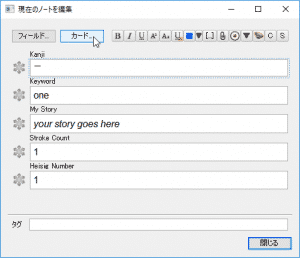
Here you want to click “Card” (カード) which will display a new window showing you the code that is used to display all the elements on your flashcards.
Now don’t panic, this next step is really easy so just do as I do.
First move the 4 highlighted lines for the kanji fonts which are on the bottom section (which is the back of the card) to the top section (the front of the card).
Each line should contain {{Kanji}} in them somewhere.
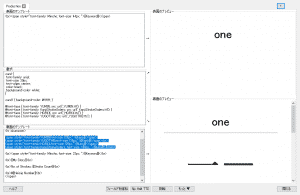
Once you’ve done this just take the line that has {{Keyword}} in it from the top of section and put it in the bottom section just above where the other line that has {{Keyword}} in is. You can just delete this line and you can be done if you are okay with having the keyword be a smaller font on the back.
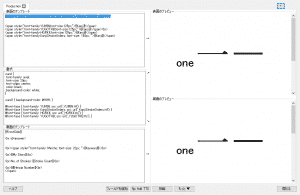
After this is done I would delete the other line that has {{Keyword}} in it from the back of the card as you don’t need it on there twice.
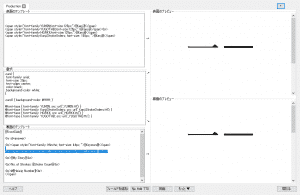
Once this line is deleted, you can close the window and go back to studying your cards to see the difference.
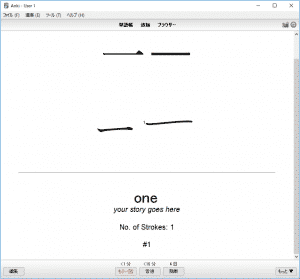
As you can see, we now have the character on the front of the card and the keyword on the back.
That’s all you’ve got to do.
From here on, just continue studying with this guide and Remembering the Kanji but just ignore anything about writing kanji.
I just want to get it across to you one more time before you go ahead and do this though…
JUST REMEMBER YOU WON’T BE ABLE TO WRITE THEM IF YOU DO THIS. YOU HAVE BEEN WARNED.
Okay, now if you go ahead and do this then it’s your fault not mine, so don’t come crying to me in 2 years time asking why you can’t write Japanese…
Do I Really Need to Do 3000 Kanji? I Thought I Only Needed to Know 2000?
It’s true that there are only 2000 or so kanji that are used in the Jōyō kanji, and to be fair you could get away with not doing the extra 1000 that Heisig introduces in Remembering the Kanji 3, however I still recommend that you do all 3000.
I would argue that you wouldn’t save anytime either way though. If you spent the extra month it takes to learn them then that means it’ll take you an extra month to get into studying Japanese with sentence flashcards and by reading real Japanese.
On the other hand though, if you don’t spend that extra month learning them then you will get into studying sentences and reading Japanese quicker but it will be ever so slightly harder for you to pick up those kanji that you haven’t learnt in Remembering the Kanji when seeing them in real Japanese.
In the end it would probably take around about the same time to become able to read Japanese “fluently”, the only difference being that you won’t be able to recall and write the extra 1000 kanji, that you didn’t study via Remembering the Kanji 3, by hand.
It’s therefore more beneficial for you to do Remembering the Kanji 3 straight after you finish 1.
Both 1 and 3 are included in my deck so just keep going until you finish the entire deck.
How Long Will This Take?
I’ve been saying throughout this post that this can be done in 3 months and I say that from experience. However, it’s highly likely that you aren’t a university student with plenty of time on your hands.
If you aren’t then don’t panic about not being able to do this in 3 months, just take it day by day and in the long run you will still end up learning to read Japanese quicker than most other westerners that don’t use Remembering the Kanji.
If you want to challenge yourself to get this done in 3 months though then here are some stats that you are going to need.
In my opinion this shouldn’t be a race but stats are great and can keep you on track so I recommend you keep checking your progress as you do this.
To complete all 3000~ kanji in 90 days you will need to do 34 kanji a day. To learn all of them in one day you are going to need a fair amount of time.
I would recommend 3 minutes at least on each character which will take you to 1 hour and 42 minutes a day.
When it comes to making stories though you may find yourself getting distracted as you end up thinking about your stories too much. You don’t want to create a novel so try to keep things short, sweet and get it done quickly.
The best way to force yourself to do this is to have a timer go off every 3 minutes and if you still haven’t finished creating your story then you should either use Heisig’s story or hop over to kanji koohii and use a community story.
If you do this though then bare in mind that your ability to recall this story will be decreased and you may have difficulties with it. If this happens then fix the issue when reviewing the kanji later on.
Bare in mind that the 1 hour and 42 minutes per day that you are spending on learning kanji is only the time you are spending on learning new characters.
Don’t forget that you still have to review all your other cards first.
Depending on the person this can take barely anytime at all or it can take ages. Either way I want to introduce you to a small trick that should hopefully speed up the process for you.
Time-boxing
One of the best techniques I suggest implementing is time boxing/the pomodoro technique. Time-boxing is a trick that gets you to cram as much work as possible into a certain time frame.
Us humans are actually pretty inefficient.
Take a moment and think about your general day. Consider how much time you actually spend working and how much you spend doing something else and you will see what I mean.
Let’s take University student as an example.
Most students, when given 2 months to complete an assignment that could take 40 hours most students will end up starting it a week before the deadline, which is just crazy!
Having lots of time usually causes procrastination due to being overly optimistic about your ability to get a task completed, meaning that you’ll slack off because you feel like you have loads of time to get the task done.
But even if this is the case, how come students can manage to do this for bigger projects and somehow manage to complete an assignment that should take a week, in less than a day? While still getting a decent grade of course…
I doubt many of them are aware of what is happening to them in that last week or so but the answer is time boxing.
The pressure of running against the clock forces them into overdrive and allows them to finish the assignment by using the effect of time boxing to enter a “full concentration state” also known as “deep work“.
Implementing time boxing is really easy.
You give yourself a time period and say to yourself “Right, I am going to get this task done in n minutes”. The goal has to be possible, but also a little bit difficult, allowing you to feel good about completing it.
It’s essentially turning your everyday boring work into small segmented games by timing yourself against the clock.
For me, I like to set a timer for 10 minutes and see how many Anki flashcard reviews I can do in that time-frame.
It has allowed me to dramatically reduce my study time for university, and Japanese, so I highly recommend that you take a look at it.
Can’t I Just Use Other People’s Stories For All My Cards?
No.
Use other people’s stories sparingly and as a back up.
The easiest to remember stories are the ones that you make yourself, that hold meaning to you and that you can relate to.
You will save yourself time in the long run by making your own stories anyway so no, don’t be lazy because in the end you won’t be saving yourself time, as you will have to go back and study a lot of the characters again from scratch by making your own stories.
Only use other people’s stories as a back up if you find yourself really stuck.
Other Advice and Tips
Sleep
Getting decent sleep is probably the one thing I want you to take away from this section. Getting good sleep and waking up at roughly the same time everyday will keep you in peak condition for learning just about anything.
In order to do this I recommend that you use the Sleep as Android app which detects which phases of sleep you are in and will wake you up during a light sleep cycle instead of a deep sleep cycle. This will prevent you feeling like you’ve been hit by a truck when you get out of bed in the morning, thus setting you up for a better day.
If you are on iPhone then Sleep Cycle alarm clock should do the trick.
Remove Distractions – No Multi-Tasking!
Multi-tasking doesn’t work, and it’s not just us men either.
There’s tonnes of research backing up this fact so please just don’t waste your time trying to do multiple things at once.
The moment you sit down to do your reviews in Anki, put your phone on silent and hide it from your sight, close any open programs or tabs on your PC, stop watching TV and just focus entirely on the task at hand.
You might even want to go to your local library to study if your home is full of distractions.
You will find that you will be able to focus easier and get the task done quicker, allowing you more time to do everything else afterwards. That means more time binge watching Japanese TV! 😀
“I Just Can’t Do Remembering the Kanji, IT SUCKS!”
Alright look, it doesn’t suck.
You are having an issue with either the process or your attitude towards it.
Attempt to figure out what that issue is, fix it and try again. It may be that you aren’t doing the method properly, it may be that you have issues studying effectively, it could be a many number of things so narrow it down, fix it and keep going.
If, after trying this, you still have problems then just face the fact that this is still going to be the fastest route for you if you want to become able to read Japanese like a native, whether you enjoy the process or not. There’s nothing else I can really tell you besides this and to simply “keep going”.
Tracking Your Progress
As you progress you may find yourself wondering when you are going to get this finished. The early stages especially can be quite painful so I highly encourage you to check your statistics in Anki in order to keep your motivation up.
You can do this by clicking the small “graph” button next to the “sync” button. On doing so loads of graphs will appear showing you how many cards you are learning, how many you have put into long-term memory etc.

Keeping track of your progress and completing mini goals can be a great way of keeping you motivated. For more on mini goals check out the following post: Language Learning Goals Template.
“Is There Anything Else I Might Need?”
It’s recommended that you buy yourself a 漢字帳 which is a specific note-book designed for kanji writing practice.
They come with boxes and you should attempt to fit each kanji in each box. Most of them also have some example words to copy out in order to help improve your handwriting.
Using boxed paper to practice with will help you to write neatly even when you don’t have any 原稿用紙 lying around and have to use normal paper.
You should also get some 原稿用紙 too. This is just the boxed paper and won’t come with any tips like the 漢字帳.
You can also grab some cheap pens that are specifically designed for writing kanji. They make it easier for you to get better handwriting as they are designed with kanji strokes in mind.
All these can be found on Amazon.jp, if you can’t read Japanese yet then you can change the language to English by clicking the button that has a globe and that says “JP” on it (near the top right next to your account name).
You can import from Amazon JP so that’s not a problem, however the specific items I will link to might not ship to your country so just take a look around.
I recommend popping into Daiso if you live in Japan and getting there versions as they are cheap and do the job well, unfortunately I couldn’t find them on Amazon.
Some 漢字帳 and 原稿用紙 on Amazon:
Bare in mind that you will probably need to buy a few of these as you will be writing a LOT.
I would also recommend this kanji handwriting pen 楽々筆ペン (this thing works wonders and I love it) which you can get in Daiso for 100 yen if you live in Japan.
What About Kanji That Aren’t in Remembering the Kanji?
There are many other characters that are not covered by Remembering the Kanji. While you do not need to know all of these extra characters, there are a few that you will see a lot in Japanese text and you may want to learn.
For these you are partially on your own as Remembering the Kanji doesn’t provide keywords for these characters, however, there are some good websites that you can use to get keywords from.
I recommend kanjikoohii as your main resource for getting keywords as it’s designed for learners of Remembering the Kanji (although you shouldn’t rely on it for stories, always make your own stories as they will stick better in your long-term memory).
It would also be a good idea to consult a kanji dictionary to see if any of the components that build up a character aren’t a separate character in themselves with a specific meaning that you could use.
I actually created an Anki deck for kanji that are included in the 日本漢字能力検定 which is a super hard kanji test for Japanese speakers. This deck includes an extra 2656 kanji. I have yet to add keywords to it though. You can get access to the deck on my patreon here.
What Should I Do After I’ve Learnt All The Kanji?
After you have finished learning kanji, you are going to want to learn native Japanese sentences via sentence mining. You should also be immersing yourself in as much Japanese content as you can while you learn kanji and you should continue this afterwards as well.
The following blog posts, videos and websites should help you out for what to do next and if you want even more content from me personally then check out my patreon page here.
Useful blog posts and videos
Language Learning Resources – Link Roundup
Maximize Your Listening | Strategies to Improve Listening Comprehension
Learning Japanese Online Free With Audio | Free Japanese Listening Resources
Interviewing MattVSJapan About Learning Japanese/Languages | Tips For Learning Japanese
How to Make SRS Sentence Flashcards Quickly and Efficiently
Easy to Read Manga! Japanese Book Reviews #1
Get Thousands of Contextual Sentences for Language Learning (Sentence Banks)
Other useful links
Take a look at these links as they will give you an idea as to what to do next.
They will also help you get to grips with how to actually learn Japanese efficiently and to incredibly high levels of proficiency.
I plan on creating more guides like this one on the other main areas of language learning and learning Japanese too so if you want notifications as to when these are posted then join my newsletter or follow me on twitter.
Anyway, I wish you the best with your Japanese studies and I hope that you’ve found this guide to James Heisig’s Remembering the Kanji helpful!
Thanks for reading!
Click here for more information on learning languages
マット
By Matthew Hawkins2018/06/11Massive thanks to Diederik and everyone else supporting me on Patreon. You guys are awesome! 🙂Follow me on TwitterSupport me on Patreon to get early access to posts and exclusive contentHere are some of my favorite tools and sites for learning Japanese
Thank you for reading this blog post, which I hope you found useful for learning Japanese. Here are some of the most useful websites that I’ve found for finding Japanese content to use for immersion as well as some really useful learning tools to help you through your Japanese studies. Some of these are affiliate links which just means that if you decide to use these sites by clicking the following links, then I will earn a commission. But honestly speaking, these are the sites that I use and recommend language learners, even my friends, to use anyway.
Anki Tools: To get started, I really like Migaku for Anki. By itself, Anki is already a super useful tool for language learners but Migaku allows for integration with websites like YouTube and Netflix, allowing it’s users to create flashcards from the shows and videos that they are watching, as they are watching them. If you use my link you can get an extra month for free.
Speaking Practice: For this I absolutely love iTalki. There are thousands of Japanese teachers on the platform that are available at all times of the day to have conversations with you, in Japanese. Some teachers take a more traditional approach while others are just there to chat, these are the ones I would recommend if you are looking to improve your conversational Japanese. Lessons start from just $5 and there’s no long term commitment, I highly recommend them.
Immersion: I’ve used a lot of different earphones / headphones over the years but by far the one that has come out on top is the NENRENT S570. This is a singular in-ear earphone that matches your skin tone to keep it discrete, meaning you can listen to the language you are learning while at work, or school. For a full list of tools and gadgets I recommend for maximizing your immersion time, check out this blog post.



8 Replies to “How to Learn Kanji Fast: The Ultimate Guide to Remembering the Kanji”
Comments are closed.